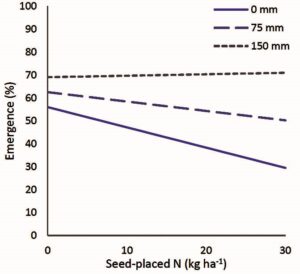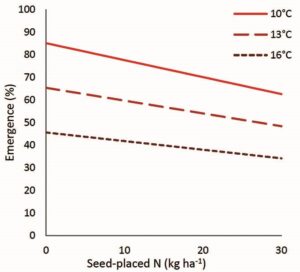Better estimate emergence this spring to hit your target plant population
Click here to use the target plant density, seeding rate and seed cost calculator, and Canola Counts survey tools to support your seeding plans and assessments this growing season.
The Canola Council of Canada recommends targeting a canola plant population of five to eight plants per square foot to balance yield potential and economics. To achieve a target plant density, you need to know the seeding rate, thousand seed weight (TSW) and estimated emergence percentage. But with an average of 60.7 per cent and a range of 20-90 per cent, canola emergence rates can vary by management practices and field conditions. Quantifying these values could help farmers better adjust their rates under certain conditions.
Christiane Catellier’s project, ‘A meta-analysis of small-plot trial data to examine the relationship between crop development and environmental conditions in canola,’ aimed to address this. (Find the report at canolaresearch.ca.) The research used archived small-plot canola agronomic trial data (from 12 projects conducted across 47 site-years in Saskatchewan and Manitoba from 2013-22) and corresponding regional weather data to investigate the relationship between environmental conditions and canola emergence.
Key outcomes
- Seeding date and average air temperature before and after seeding had the most influence on emergence and appeared to be related to soil moisture.
- Seeding density, seeding date, seed-placed fertilizer and average pre- and post-seeding air temperature all had negative effects on emergence percentages, while pre- and post-seeding precipitation had positive effects on emergence.
- Pre-seed precipitation was more influential on emergence (varying from 53 to 72 per cent) than post-seed precipitation (varying from 57 to 73 per cent).
- The effect of seed-placed fertilizer (nitrogen, phosphorous, and/or sulphur) on emergence varied with seeding date, pre-seed precipitation and post-seeding temperature. Seed-placed fertilizer had little effect on canola emergence when seeded later. When seeded earlier, there was a significant reduction in emergence with increasing rates of seed-placed fertilizer.
- The effect of seeding density varied with seeding date, pre-seed precipitation and pre-seed temperature.
- Interacting effects between management and environmental variables were more likely under more ideal conditions of the most influential variables, specifically earlier seeding dates, lower average temperatures and higher precipitation.
- Seeding later appeared to have a stronger effect on canola emergence than seed-placed fertilizer.






